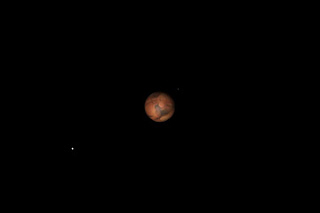Have You Watch Mars Align starry Twins on Sunday?
 |
| Mars is now a bright
object in the morning sky. For the first three weeks of August, Mars is
in Gemini, then on August 25 it moves into Cancer. |
Mars is currently rising in the east-northeast just before 3:30 a.m. your local time. The Earth is very slowly catching up with Mars in its orbit around the sun, yet the Red Planet has not brightened much at all since early July.
Mars remains at a magnitude +1.6; closer to the ranking of a second magnitude object. Astronomers measure night-sky object brightness in terms of magnitude, in which lower numbers denote brighter objects. Stars and planets with negative number magnitudes are exceptionally bright. [Amazing Night Sky Photos for August (Gallery)]
The chief reason that Mars has not brightened much lately is that it is still at a rather large distance from us: 215.6 million miles (346.8 million kilometers) as of Sunday morning. And if you have even a moderately large telescope, the disk of Mars remains disappointingly small, just 4 arc seconds across. You would need a magnification of no less than 450-power to make Mars look as large the moon looks to us with the unaided eye.
What's really interesting about Mars is the stellar scene that it's currently passing through. The planet will form a nearly perfectly straight line with Castor and Pollux, the two brightest stars of the constellation Gemini, the Twins. On Sunday morning, the trio will align in a Mars-Pollux-Castor order, running from the southeast (lower left) to northwest (upper right).
Or, you can go in the other direction. If you extend an imaginary line through Castor and Pollux, 1.5 times the distance between them and down toward the horizon, you'll come to Mars. Mars and Castor appear of equal brightness, while Pollux is about half a magnitude brighter.





